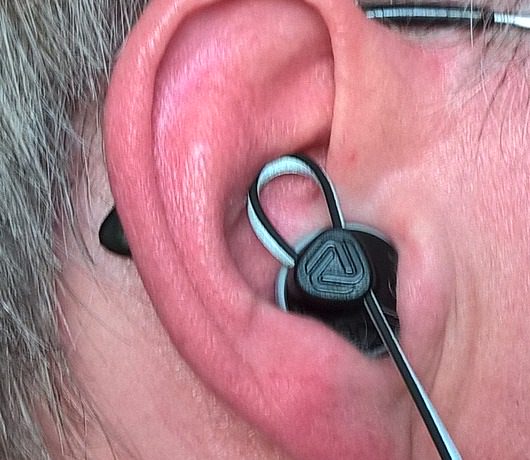Review: Triple Lumia headset review: Microsoft Comfort, Coloud Hoop and Boom
What's a reviewer to do when faced with a trio of official Lumia headsets but to review them? They range in price and purpose too, thankfully, giving me something to get my teeth into - or at least my ears. The one sentence summary if you're into audio quality? Pass on the Comfort and make a beeline for the two Coloud accessories - they're of higher quality in several ways.
(Not mentioned or shown specifically, but each of the headsets here features integrated telephony, i.e. a microphone in a pod in the main lead, together with a 4-pole jack suitable for any modern smartphone)
Let's start with the Microsoft Comfort Headset though, since it's the cheapest. As the name suggests, comfort is the priority here, at least in terms of outer-ear headphones, with an irregular shape that's reminiscent of that introduced by Apple for the iPhone 5 range. Essentially the sound is projected into the front part of the ear canal, with reflex holes improving bass and an aperture on the back letting in external sounds (for safety):

These are among the best of the outer ear headsets I've tried, but don't expect too much. At £13 in the UK, you're not getting much in the way of quality audio components, and it shows. Music lacked bass and had the familiar 'cheap' sound from outer-ear headsets of this grade.
Still, they were comfortable and, importantly did a pretty good job of staying in the ear when walking.
Next up is the Coloud Boom - these are made by a Swedish company specifically for Microsoft's handsets under the 'Coloud' branding, and the Boom model is the traditional 'over the top' headphone style, with large speaker components and padded cushions:

Fit and comfort was terrific here, as you might expect. Note that the Boom set is sculpted so that, like the outer-ear headphones, you have to get Left and Right the right way round, otherwise they feel odd on the head - there's a very slight camber to match the angles of the average human head.
Audio quality was excellent, with good bass and treble and good separation from the world, thanks to the bulk of the headphones and padded design. However, I have to critise the same padded cushions - they do feel quite cheap, obviously based on simple foam and with a thin synthetic cover that doesn't look like it will stand up to the rigours of daily life. The Boom retails at about £22 (here on Amazon UK) and the materials used are perhaps not surprising, but it's very telling to compare this accessory to over-ear headphones costing £40 or so (e.g. the Urbanears range), since the latter have much higher quality materials for the cushions and their filling.
At twice the price of the Comfort headset then, twice the audio quality - and ten times the bulk, but hey....
Finally we have the most interesting of the three headsets, the Coloud Hoop, which should cost 30 Euros, so about £25, though I found it hard to find anywhere which claimed to sell this yet. The idea here is to optimise everything for running and walking, with a unique little extension to the semi-rigid cable at the headphone end, designed to form a small 'hoop' that can be tucked into one of the ridges in your outer ear. It sounds odd but works surprisingly well.

In addition to the 'hoop' design, there's a full three-button set of controls in the pod, so that you can adjust volume easily without having to stop running in order to take your phone out of your pocket, etc. Plus the cable itself is made of reflective material - at night this will 'light up' when a car approaches you, making you that little bit more visible, should you prefer to exercise in the evenings.

Shot with flash, showing the reflective coating!
The nature of this sort of semi-rigid cable also helps in that it's almost impossible to get it tangled, a perennial difficulty with headsets.
Most importantly of all, perhaps, the audio quality from the Hoop was much better than that from the Comfort design above, despite having similar outer-ear shape - it's clear that a higher quality speaker component was used, perhaps fitting the £25 (or so) price tag. Audio still wasn't up to the levels of the £30 Arcana in-ears, but then you'd expect more from something filling the ear canal, something which not every person likes.
The 'hoop' design proved the most fascinating aspect, of course, I'd never seen this before and it took a couple of minutes before I'd worked out what to do - the diagram on the packaging isn't very clear. How large you have the hoop and quite which bit of your ear it sits in will vary from person to person, but after a little trial and error I had the Hoop headset firmly lodged and no amount of running around would shift it.

Aside from discovering that it's hard to photograph one's own ear, this shot does show how the 'hoop' part of the design nestles up inside one of the natural ridges in the human ear - quite clever really!
Add in the integral (very sturdy) lapel clip for the cable and a 'lassoo' system at the jack end for helping keep the cable tidy when not in use (the Boom also has this, by the way) and you have just about the perfect modern headset for sporty types.
______________
Three very different headsets for Lumia (and similar) smartphones then - the Hoop is the most interesting and most worthy of recommendation by some way, but I'd also give a shout out to the Boom for really good audio, even if I have worries about the materials used.
Reviewed by Steve Litchfield at
